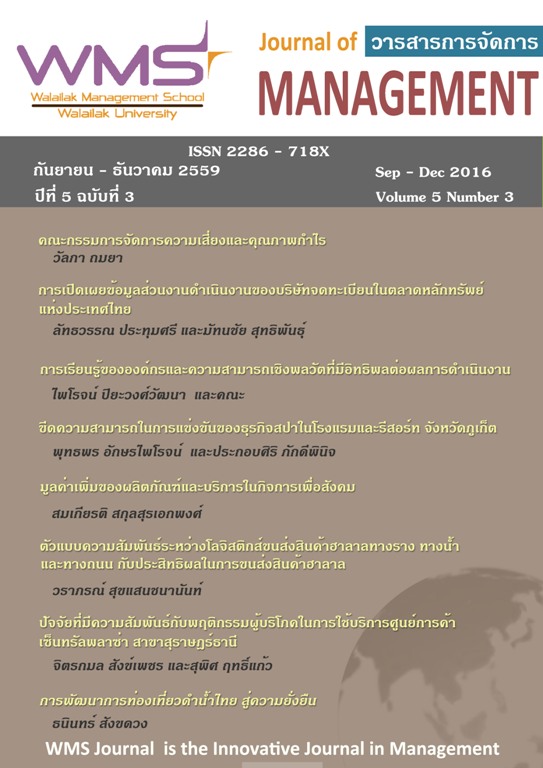Value-Added Product and Service in Social Enterprise
Main Article Content
Abstract
The purposes of this research were to determine 1) the factors of value-added product and service in social enterprises of Thailand and 2) the value-added product and service influencing factors effect effectiveness of social enterprises of Thailand. 150 leaders of social enterprises in Thailand for this study were selected by simple random sampling. The quantitative research methodology was applied and the research instruments were five level scale type questionnaires. The researcher uses Structural Equation Modeling (SEM) methodology to analyse the data.
The results of the study found that factors loading of value added product and service variables on the effectiveness of social enterprises of Thailand were all positive and significant at the level of .01 (b between 0.603 and 0.894) ; Needed Value (Y3) (b=0.894) Experienced Value (Y4) (b=0.737) Monetary Value (Y5) (b=0.677) Functional Value (Y2) (b=0.659) and Innovation Ability (Y1) (b=0.603) respectively.
The results indicated that the hypothetical causal model was consistent with the empirical data. It shown that the variables in the model accounted for the SE Effectiveness. At a 0.01 confident level, Value-added Products had a statistically significant direct effect. SE Effectiveness
Article Details
References
เกวลิน มะลิ. (2557). กิจการเพื่อสังคมในประเทศไทย. วารสารเศรษฐศาสตร์และกลยุทธ์การจัดการ, 1(2),104-112.
กัญญามนต์ อินหว่าง และวัลลภา ศรีทองพิมพ์. (2551). แนวทางการพัฒนาระบบการจัดการของธุรกิจขนาดกลางและขนาดย่อมด้วยการใช้ปรัชญาเศรษฐกิจพอเพียง (รายงานการวิจัย). กรุงเทพฯ: สำนักงานคณะกรรมการวิจัยแห่งชาติ.
ขยะไม่แขยง. ม.ป.ป. Waste Enterprisers. สืบค้นเมื่อ 30 กันยายน 2556, สืบค้นจาก www.tseo.or.th/sepresent/1523.
จำพวกของซีเอสอาร์. (2551). สืบค้นเมื่อ 30 กันยายน2556,สืบค้นจาก www.thaicsr.com. [].
ณัฐพล อรุณยะเดช. (2551). ปัจจัยทางเศรษฐศาสตร์ที่มีผลต่อการวิจัยและพัฒนานวัตกรรมและผลิตภาพการผลิตในประเทศไทย. วิทยานิพนธ์เศรษฐศาสตรมหาบัณฑิต, มหาวิทยาลัยธรรมศาสตร์.
พารนี. (2555). Paperista เครื่องประดับ "พิทักษ์โลก". เส้นทางเศรษฐี, 18(309), 58.
ศิริวรรณ เสรีรัตน์ และคณะ. (2545). องค์การและการจัดการ. กรุงเทพฯ: ธรรมสาร.
ศูนย์ส่งเสริมและพัฒนาพลังแผ่นดินเชิงคุณธรรม สำนักงานบริหารและพัฒนาองค์ความรู้ (องค์การมหาชน). (2552). ฝ่าวิกฤตด้วยคุณธรรม : การสร้างธรรมาภิบาลในภาคธุรกิจอย่างยั่งยืน. ในเอกสารประกอบการประชุมสมัชชาคุณธรรมแห่งชาติครั้งที่ 4. กรุงเทพฯ: สถาบันวิจัยสังคม จุฬาลงกรณ์มหาวิทยาลัย.
สมนึก เอี้อจิระพงษ์พันธ์ และคณะ. (2553). นวัตกรรม: ความหมาย ประเภทและความสำคัญต่อการเป็นผู้ประกอบการ. วารสารบริหารธุริจ คณะพาณิชยศาสตร์และการบัญชี มหาวิทยาลัยธรรมศาสตร์. 33(128). 49-65.
สฤณี อาชวานันทกุล. (2555). SE catalog รวมกิจการเพื่อสังคมในไทย. บทสัมภาษณ์: ความแตกต่างของคาว่า CSR, Social enterprise และ Social Business. กรุงเทพฯ: แอคมี พรินติ้ง.
สำนักงานนวัตกรรมแห่งชาติ. (2547). สุดยอดนวัตกรรมไทย. กรุงเทพฯ: สำนักงาน.
สำนักงานสร้างเสริมกิจการเพื่อสังคมแห่งชาติ. (2555). แผนแม่บทสร้างเสริมกิจการเพื่อสังคม พ.ศ. 2553 – 2557. สืบค้นจาก http://www.tseo.or.th/article/1331.
สำนักงานสร้างเสริมกิจการเพื่อสังคมแห่งชาติ. (2555). SE Catalog รวมกิจการเพื่อสังคมในไทย. กรุงเทพฯ: แอคมี พรินติ้ง.
สำนักส่งเสริมและพิทักษ์ผู้ด้อยโอกาส. (2557). เอกสารประกอบการประชุมผู้บริหาร สำนักงานส่งเสริมสวัสดิภาพและพิทักษ์เด็ก เยาวชน ผู้ด้อยโอกาสและผู้สูงอายุ (สท.). 5 กันยายน 2557. กรุงเทพฯ: สำนัก.
ไอศครีมเพื่อสังคม อุดมสุข. ม.ป.ป.. สืบค้นจากwww.tseo.or.th/news/1605. FarmSook Ice Cream
Ansoff, I. Harry. (1989). Corporate strategy. Harmondsworth, England: Penguin Press .
Argandona, Antonio. (2011). Stakeholder theory and value creation (Working paper WP-922). Navara,Spain: IESE Business School, University of Navara.
Armstrong, Garry., & Kotler, Philip. (2003). Marketing and introduction (6th ed.). New Jersey: Pearson Education.
Bornstein, David. (2004). How to change the world: Social entrepreneurs and the power of new ideas. Oxford, England: Oxford University Press.
Borzaga, Carlo., & Defourny, Jacques (Eds.). (2001). The emergence of social enterprise. New York: Routledge.
Coggins, Eric. (2009). Five characteristics of social Enterprenuership (online). Retrieved from www.suite101.com. [2013, September, 30].
Drucker, Peter F. (2002). Managing in the next society. Oxford, England: Butterworth Heinemann.
Etzel, Michael J., Walker, Bruce J., & Stanton, William J. (2004). Marketing (13th ed.). Boston, MA: McGraw-Hill.
Freeman, R. Edward. (1984). Strategic management: A stakeholder approach. Cambridge, England: Cambridge University Press.
Hair, Joseph F., Black, William C., Babin, Barry J., & Anderson, Rolph E. (2010). Multivariate data analysis. (7th ed.). New Jersey: Pearson Education.
Kim, W. Chan, & Mauborgne, Renee. (2005). Blue ocean strategy: How to create uncontested market space and make competition irrelevant. Boston, MA: Harvard Business Press.
Lazer, William. (1971). Marketing management: A systems perspective. New York: John Wiley & Sons.
Matten, Dirk., & Moon, Jerry. (2004). Implicit and explicit CSR: A conceptual framework for a comparative understanding of corporate social responsibility. Academy of Management Review, 33(2), 404-424.
Perry, Chad. (1987). Growth strategies: Principles and case studies. International Small Business Journal, 5(2), 17-25.
Porter, Michael E. (1985). Competitive advantage: Creating and sustaining superior performance. New York: Free Press.
Schumacker, Randall E., & Lomax, Richard G. (2010). A beginner’s guide to structural equation modeling (3rd ed.) New York: Routledge.
Smith, David. (2006). Exploring innovation. Berkshire: McGraw-Hill Education.
Smith, J. Brock. & Colgate, Mark. (2007). Customer value creation: A practical framework. Journal of Marketing Theory and Practice, 15(1), 7-23.
Swan Bake! Swan Bakery (online). (n.d.)
Retrieved from www.tseo.or.th/sepresent/1323.
, November, 25].
Watts, G., & Cope, J., & Hulme, M. (1998). Ansoff's matrix, pain and gain: Growth strategies and adaptive learning among small food producers. International Journal of Entrepreneurial Behaviour& Research, 4(2), 101-111.


